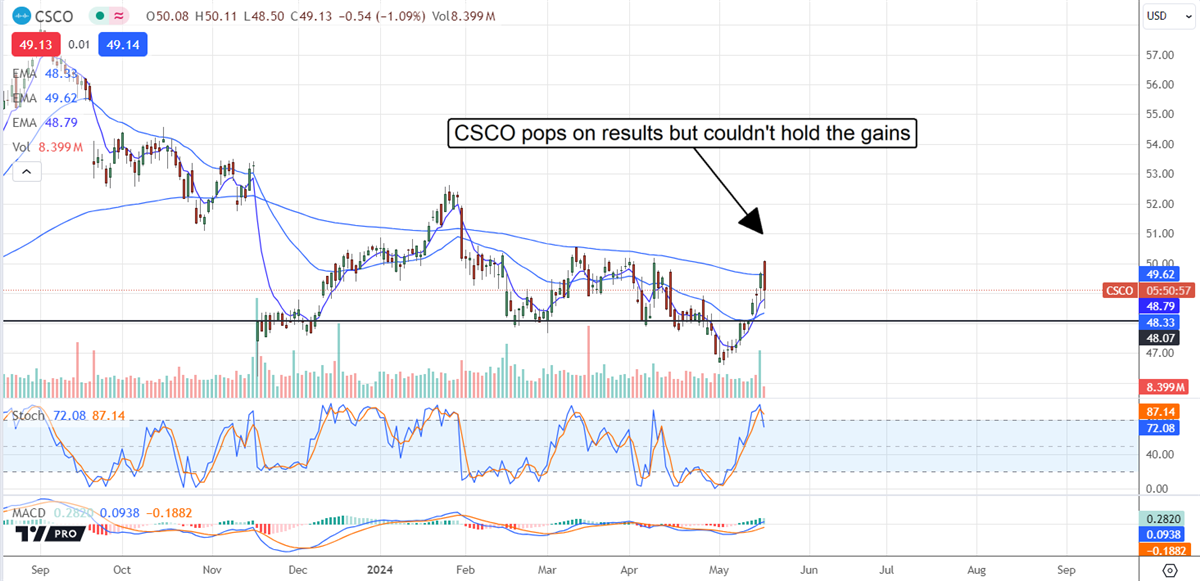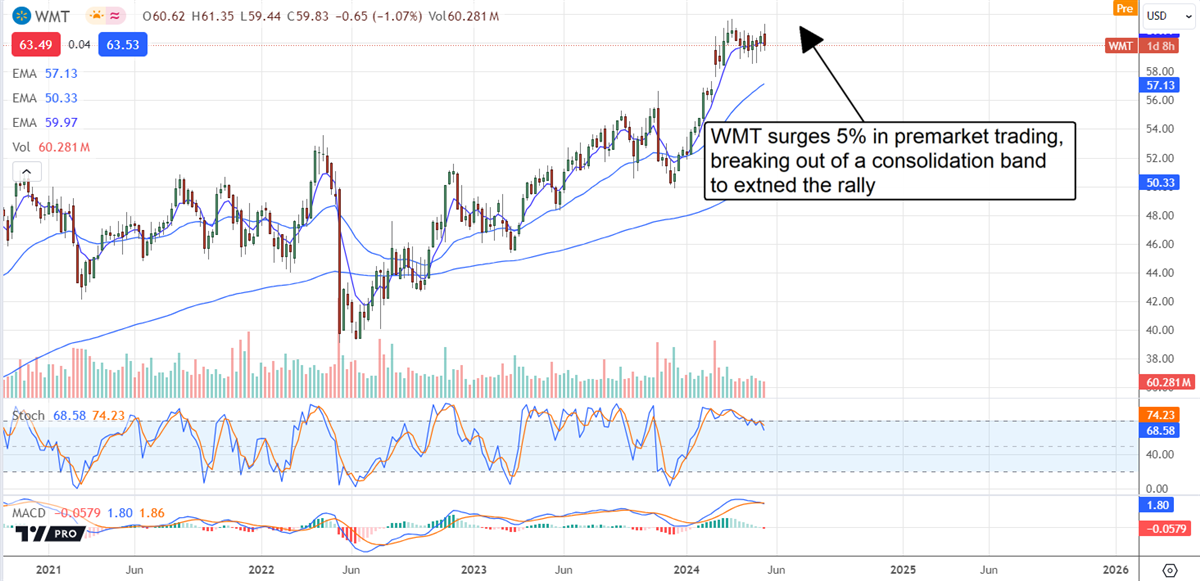Ticker Reports for May 16th
The Real Reason Michael Burry is Buying Physical Gold
Michael Burry, the legendary investor who predicted the 2008 financial crisis, has once again made waves with his latest 13-F filing.
While he added to and trimmed several positions, the standout move was his new investment in Sprott Physical Gold Fund (NYSEARCA: PHYS). In this article, we'll delve into the highlights of this filing and why he chose to invest in physical gold over other forms of the precious metal.
Burry is the maverick investor who netted $700 million during the 2008 financial crisis by betting against the housing market—a feat captured in the award-winning film The Big Short—and is widely regarded as a prescient Wall Street outsider.
Since his famous bet, he has made several notable trades. He strategically invested in water assets, anticipating future scarcity, and bought into GameStop (NYSE: GME) in 2019 before it became the poster child of meme stocks. During the COVID-19 pandemic, Burry purchased put options on equity indices, anticipating market turmoil amid the global crisis.
In his latest 13-F filing (an SEC report that details large managers’ equity holdings), Burry shows a substantial new position in Sprott Physical Gold Trust, which now makes up 7% of his portfolio. This move highlights his focus on physical gold as a hedge against economic instability and inflation.
Here are some key reasons why gold is relevant for any investor's portfolio:
- Long-Term Store of Value: Gold's industrial use and limited supply make it a reliable long-term store of wealth, trusted for centuries. The metal also protects against the eroding effects of inflation.
- Fed Policy Misstep: Gold serves as a safeguard against potential Federal Reserve policy errors, especially as the Fed is under pressure to cut rates amid rising inflation and public deficits.
- Fiat Devaluation: Gold hedges against the devaluation of the US dollar and fiat currencies in general, offering stability when confidence in traditional money wanes. The rise of Bitcoin also reflects this trend.
So…gold makes sense. But why physical gold?
Investors have multiple ways to gain exposure to gold, including ETFs, gold mining stocks, and futures. There are a few reasons why he chose the Sprott Trust specifically. Let’s find out why.
1. Direct Exposure
The Sprott Physical Gold Trust offers direct exposure to gold bullion, providing a way to invest in gold without the operational and management risks associated with mining companies. Investors purchase real gold stored in secure vaults, which is more stable and less volatile than mining stocks.
2. Reduced Operational and Management Risks
Gold mining companies face various operational risks, including high fixed costs and regulatory issues, particularly as many gold mines are in politically volatile regions. Investing in PHYS eliminates these risks, as it purely tracks the price of gold without the added complexities of mining operations.
3. Redemption Feature
This is the key to Burry’s decision. Subject to minimum quantity requirements, PHYS allows investors to redeem their units for gold bullion, a unique feature not offered by most gold ETFs.
A doomsday investor like Burry wants the ability to retrieve gold if markets are going through an extreme crisis. In a scenario like that, a regular ETF investor might face a situation in which the ETF issuers are in financial trouble themselves and may not fulfill their obligations. The Sprott redemption feature eliminates that risk for Burry and other investors.
Burry made other significant changes to his portfolio in the first quarter of 2024. He bolstered his stakes in Chinese tech stocks JD.com (NASDAQ: JD) and Alibaba (NYSE: BABA), bringing his total holdings in these companies to $9.9 million and $9 million, respectively. On the flip side, he completely exited his positions in tech names such as Oracle (NYSE: ORCL), Google (NASDAQ: GOOGL), and Amazon (NASDAQ: AMZN).
Investing in gold carries risks, particularly if inflation subsides. The appeal of gold would also diminish if the Federal Reserve begins a rate-cutting cycle. For investors looking to hedge against inflation and market instability, however, following Burry’s lead could provide a robust and tangible store of value.
Trump Warns Gov. Can Confiscate Your Money. CBDC's give Gov. absolute
Donald Trump once again sounded the alarm against Fed-controlled digital currencies (CBDCs).
If these plans are implemented, it could mean the end of America as we know it.
Cisco Systems Rebound is On: Double-Digit Upside to Come
Cisco Systems' (NASDAQ: CSCO) headwinds are diminishing, opening the door to a rebound and sustainable rally that could lift the share price by double-digits. While end-market inventory normalization is still underway in the networking segment, other segments are growing, and the integration of Splunk is progressing well. The takeaway is that an inflection point is at hand that will lead the company back to growth, and that should lead to increased share prices. The only question is if the market can rally over the summer or if it will wait until later in the year.
Cisco Systems Q3 is Better Than Feared: Guidance Favorable
Cisco Systems Q3 revenue contracted 12.8% to $12.7 billion but came in better than expected. The take is $0.07 billion ahead of the consensus reported by Marketbeat.com due to the successful transition to subscription-based services. Subscriptions are up to 54% of the net, with total annual recurring revenue up 22% and product ARR up 44%.
Total product sales are down due to weakness in the networking segment, but other segments, including Security and Observability, are up by double-digits. High-end-market inventory levels impact the networking segment, but analysts expect normalization to be completed by July.
Profitability was another area of strength. The company’s GAAP and adjusted gross margin came in strong at 65.1% and 68.3% despite the decline in revenue. The net result is $0.88 in adjusted earnings, down only 12% compared to the 12.8% top-line decline and $0.06 ahead of the analysts' consensus.
The guidance is favorable and supported by a 21% increase in RPO. Guidance expects the Q4 revenue to be up sequentially and as expected relative to analysts' estimates, with strength on the bottom line. The takeaway is that, including the Q3 strengths, the full-year guidance is above consensus at the top and bottom lines, leading the analysts to raise their estimates and price targets. The post-release action is mixed; not all analysts are raising their targets, but the net result is an increase in the consensus estimate of 12.5% above the current action.
Cisco Systems Capital Returns are Safe and Reliable
Cisco Systems' cash flow and balance sheet reflect the YOY contraction and recent acquisitions but remain strong, healthy, and positioned to continue with capital returns. Highlights from the report include $4 billion in cash flow, down compared to last year, and a reduction in cash and inventory compounded by increased debt, but total assets and equity are up. Long-term debt is less than 0.5X equity, so no red flags are present.
With these metrics, Cisco’s dividends and share repurchases should continue at their current pace and may increase over time. Share repurchases reduced the count by an average of 1.2% in Q1, so they are accretive to investors. The dividend has a high yield of 3.25% and is cheap for a blue-chip tech stock, valued at only 13X earnings. The company has a track record of distribution increases, so investors may expect another low-single-digit increase this year.
Insiders Sell Cisco: Institutions Buy It
Insiders have been selling shares of CSCO, but there is nothing to worry about. The insiders own a slim 0.2% of the stock, and their activity aligns with share-based compensation and related sales. More importantly, the institutions own more than 70% of the stock and have been buying on balance in 2024. Their activity aligns with the market bottom, which formed over the past six months and provides a tailwind for the market.
The technical action following the report is mixed. The market surged by 1% at the open and was on track to continue higher, but profit-taking and a sell-the-news mentality capped gains. The market quickly reversed to fall more than 1.5%, creating a solid red candle that may cap gains over the summer. In this scenario, the market could move sideways in consolidation until later in the year when more evidence of the turnaround and return to growth is available.

This Could Wreak Financial Havoc…
America's Most Shocking Financial Story…
Behind closed doors in D.C., there is a dark political and economic plot underway. That's why if you have any savings in the bank or own any assets you want to protect, you must watch this new documentary before it's too late.
This Walmart Rally has Legs: 20% Upside Left To Go
Walmart’s (NYSE: WMT) stock is rallying because of its industry-leading position and persistent growth. The Q1 results have spurred the market to new highs, suggesting the rally still has legs. There will be volatility; the market is unlikely to move higher in a straight line, but a 20% upside is possible before the end of the year. Analysts have lifted their targets steadily this year, and that trend is unlikely to change. The pre-release activity leads the market to the high end of the target range of $175, or about 20% above the post-release pop.
Walmart has Blowout Quarter: The Bar was Set Low
Walmart had a blowout quarter, with strength seen in all metrics. The caveat is that the bar was set low, with seventeen of the twenty-three revisions tracked by Marketbeat.com being lower. Regardless, the $161.5 billion in revenue is up 6% and outpaced the consensus by 200 basis points.
All segments posted growth led by International with a 12.1% advance, 10.7% on an FXN basis. The US comps came in at 3.8%, driven 100% by transactions. Sam’s Club posted a solid 4.6% increase on a 4.4% gain in comps. Sam’s Club comps are also driven by transactions but offset by a slight decline in ticket averages. Sam’s Club also posted a solid 13% increase in membership income, indicating increased revenue and earnings leverage in upcoming quarters. However, the boost to Sam’s Club revenue may be short-lived. The company discounted memberships in April that may not get renewed the following year.
eCommerce remains a driving force for Walmart. Global eCommerce sales grew by 21% on online, same-day, and delivery strength. The Global Ad business also did well, growing 24% and aiding the outlook. Strength in all categories also aided margin. The net result is a 9.6% increase in consolidated operating income, a 13.7% increase in adjusted operating income, and a 22.5% increase in adjusted earnings. Adjusted earnings came in at $0.60, beating the consensus by more than 1000 basis points.
Guidance is among the factors driving the market. The company updated its guidance to the high end or above the previous range, above the consensus forecasts. Because the company has momentum and is gaining a share in today’s critical categories, including grocery, it may outperform its guidance and raise it despite general weakness in the retail sector.
Walmart Capital Returns are Safe, Health, and Growing
Walmart was FCF negative in Q1, but this is not a concern. Free cash flow will improve as the year progresses, leaving the capital return in solid shape. Capital return in Q1 included the dividend and share repurchases worth $1.1 billion to investors or about 0.2% of the market cap. Repurchases reduced the share count by roughly 0.35% on average YOY in the quarter and should continue steadily this year. The dividend is worth about 1.45% annually to investors and aligns with the S&P 500 average. The distribution is growing and will likely increase by another mid-to-low single-digit amount this year.
The technical action is promising. The Q1 results and guidance have the market up more than 5% and at a new all-time high. The move extends a rally in place, breaking the market out of a consolidation band, and suggests a $20 movement is in play. In this scenario, the market could advance to $80 and above the current high target set by analysts. The risk is that the market will fail to follow through on this move. Walmart shares offer an attractive price point for taking profits, which may cap gains over the summer. In this scenario, the market may pull back to retest support near $60 or lower before setting any more fresh highs.







0 Response to "🌟 This Walmart Rally has Legs: 20% Upside Left To Go"
Post a Comment